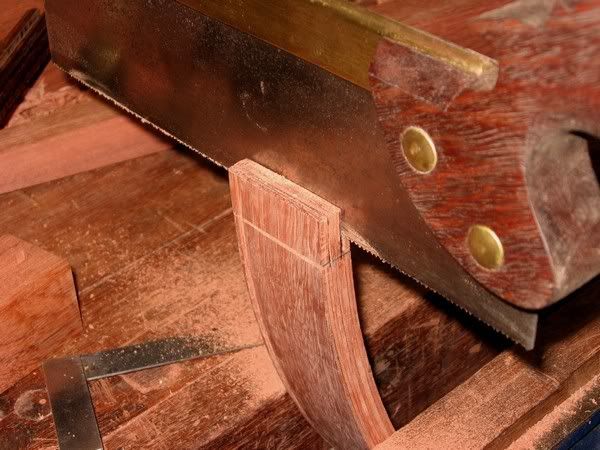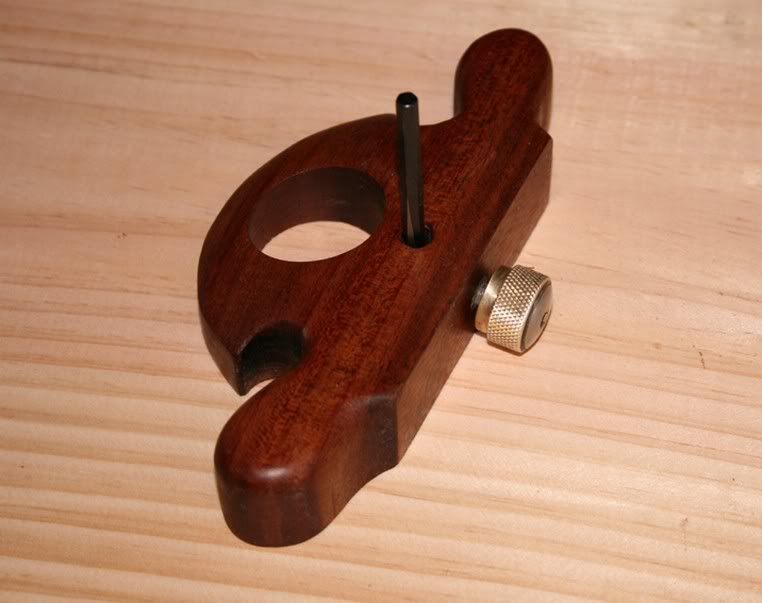|
|
Post by engineerone on Jun 19, 2008 19:09:49 GMT
at the risk of opening another can of worms.  at the moment i hand cut my m/t's, but am looking for a different and more accurate method of cutting the tenons. so far i cut the shoulders on the table saw, and then use my shoulder plane to get the sides and ends done. i could of course cut the all by the table saw, but what other methods, other than a spindle moulder ;D i am not to happy with my hand sawing methods, so paul  |
|
|
|
Post by andy on Jun 19, 2008 19:15:31 GMT
Band saw Radial arm saw Router table and of course woodrat or Legacy  |
|
|
|
Post by mrgrimsdale on Jun 19, 2008 19:45:56 GMT
Table saw - shoulders, band saw - cheeks. I set aside new bandsaw blades for tenons only, as they need to be really sharp.
cheers
Jacob
|
|
|
|
Post by paulchapman on Jun 19, 2008 20:01:20 GMT
Or you could use loose tenons, then you only need to cut the mortices. How practical this is depends on the sizes involved. You could chop the mortices by hand or use a router. In most cases, I think the result would be just as good as a conventional M&T joint and possibly better than a badly cut conventional tenon. Cheers  Paul |
|
|
|
Post by jfc on Jun 19, 2008 20:17:45 GMT
Why not over cut them by hand and then take them to your line with the plane . That way you get the practice at hand cutting them and after a while you wont need to plane them . I used to over cut them on the bandsaw and finish them on the legacy but since i bought a dragon blade i go straight off the band saw ... reminds me i need to order some more blades .
|
|
robo
Junior Member
 
Posts: 70
|
Post by robo on Jun 19, 2008 20:33:58 GMT
I use my bandsaw with a very thin 0.020" 4TPI Hakansson Meat & Fish blade from Sharpquips.
So fine, cuts like a dream!
R
|
|
|
|
Post by engineerone on Jun 19, 2008 21:16:06 GMT
jason's method i quite like but the rest of you i did ask about hand cut  paul  |
|
|
|
Post by derekcohen on Jun 20, 2008 6:19:40 GMT
Hi Paul Hand cut tenons are all about the accuracy of (1) marking, (2) sawing, and (3) tuning. Marking out is done with your favourite mortice gauge. Dimensions are taken directly from the already-cut mortice, as you are aware. Usually I either use a tenon saw to cut tenons or, if I am in a rush or lazy, I use the bandsaw. If the tenon saw, then you need to saw to the line. If this is difficult, then create a guide/fence for the saw by undercutting with a chisel all relevant lines: i13.photobucket.com/albums/a262/Derek50/Joints/Mortice%20and%20tenon%20on%20a%20curve/Chiselinglineforfence.jpgI generally just undercut the baseline, but you can also undercut the tenon face lines. This will ensure a saw cut where you want it. I generally fine tune a tenon face with either a LN joinery float or a rabbet block plane. Sometimes a rasp. Still, sometimes things are cut skew to the stretcher and then the most accurate way of fine tuning the tenon faces is with a router plane:  I do not need an outrider for the router plane if the tenon length is under 1 1/2".   i13.photobucket.com/albums/a262/Derek50/Joints/Mortice%20and%20tenon%20on%20a%20curve/Morticeandtenon-dryfit.jpg i13.photobucket.com/albums/a262/Derek50/Joints/Mortice%20and%20tenon%20on%20a%20curve/Morticeandtenon-dryfit.jpgRegards from Perth Derek ps For some reason (?) two images will not be displayed. They can be shown as a link, but not as an image. |
|
|
|
Post by mrgrimsdale on Jun 20, 2008 7:09:25 GMT
Hiya Derek snip Marking out is done with your favourite mortice gauge. Dimensions are taken directly from the already-cut mortice, as you are aware. Well that's one way, but the orthodox joinery way is to use the same mortice gauge setting for mortice and tenon, having set the gauge by reference to, ideally, a rod, or a design drawing, and/or the mortice chisel itself You have to bracket the UL wih image tags, either type them in direct or use the add tag button on the bar above: [img]URL here[/img]cheers Jacob |
|
jmk89
New Member

Posts: 37
|
Post by jmk89 on Jun 20, 2008 7:14:44 GMT
You can also do it all by hand using Japanese saws and an Anglemag www.anglemag.com. The anglemag will hold the blade steady all the way through when you are cutting cheeks and shoulders. If you use an AngleMag, you have to use a Jap saw as the back of a Western saw gets in the way! |
|
|
|
Post by derekcohen on Jun 20, 2008 7:31:21 GMT
Well that's one way, but the orthodox joinery way is to use the same mortice gauge setting for mortice and tenon, having set the gauge by reference to, ideally, a rod, or a design drawing, and/or the mortice chisel itself
Hi Jacob
You are right - that is better marking. Not sure what I was thinking of.
Regards from Perth
Derek
|
|
|
|
Post by Alf on Jun 20, 2008 8:15:36 GMT
i am not to happy with my hand sawing methods Paul, it's not the easy solution you're looking for, but I fear the answer is probably largely "practice". It really does help. If you fancy, a brief mosey over to my blog during January has a few musings on the subject. Cheers, Alf |
|
|
|
Post by engineerone on Jun 20, 2008 9:36:14 GMT
thanks again everybody. as i have said before for most people who have returned, or never done woodworking before, then hand sawing is a major problem. not least the lack of practice. and the fact that each wood you use has slightly different characteristics. actually thinking about it, the jig that veritas sell is also quite useful. alf will check your blog again  paul  |
|
|
|
Post by mrgrimsdale on Jun 20, 2008 11:01:10 GMT
thanks again everybody. as i have said before for most people who have returned, or never done woodworking before, then hand sawing is a major problem. not least the lack of practice. and the fact that each wood you use has slightly different characteristics. actually thinking about it, the jig that veritas sell is also quite useful. alf will check your blog again  paul  Practice, practice. Don't buy jigs or gadgets - you'll never learn to do it without them. Buy wood instead and waste a lot by practicing. Cheap wood like pine is harder to work neatly than hardwoods, so is doubly good for training. Make a load of little frames with 2x1x6" half housed or M&T. Throw them away or rework them. Make a collection of little crosses. Start a pets cemetery ;D But make sure you are following totally kosher procedures - face and edge marks, marking from face n edge not from the other sides, saw cuts in the right sequence etc cheers Jacob |
|
|
|
Post by tusses on Jun 20, 2008 15:49:49 GMT
Make a collection of little crosses. Start a pets cemetery ;D cheers Jacob haha ! made me chuckle ! I did just that , yesterday - on the table saw tho and practicing my carving   |
|
|
|
Post by mrgrimsdale on Jun 20, 2008 17:36:46 GMT
Very nice. Does Oliver know that the end is nigh, or is it a surprise?   cheers Jacob |
|
|
|
Post by paulchapman on Jun 20, 2008 17:42:42 GMT
They look really nice, Tusses. Cheers  Paul |
|
|
|
Post by tusses on Jun 20, 2008 18:24:34 GMT
too late for Oliver (the cat) I'm afraid  but good practice for me ! |
|
|
|
Post by mrspanton on Jun 21, 2008 20:54:25 GMT
I agree with the practice thing, as with any other skill such as drumming, writing, driving etc rome wasn't built in a day. Also dont WORRY about hand cutting. The less you worry and get all precious about technique the easier it gets. And please tell that oz bloke to stick his angle mag up his puffer mate, along with all the other trendie gadeget's. Wood working is first and foremost about manual skill, which takes time and patience to develop. Would you buy a "chordomatic" chord positioner to fit on a guitar to juice up your riffing skill and sound cool fast?? ;D Or a "gearomatic" shift lever attachement to take the stress out of changing gears ;D ;D. Or how about "scriptomatic" hand writing expert acessory-takes all the hassle out of putting pen to paper ;D ;D ;D "If the rod's right the job will come out right" Even if your stock is slightly variable if you stick with the time tested face side/face edge system your mortices and tennons will mate up perfectly. On a small one off its faster to do by hand instead of fanny about setting fences/depths etc and even THAT scenario needs plenty of practise to be acurate any way  You need advanced manual and observational skills to do it well. |
|
|
|
Post by engineerone on Jun 22, 2008 21:35:44 GMT
|
|
|
|
Post by mailee on Jun 22, 2008 21:48:10 GMT
I know this is the hand tools section but I always use a jig I made with my router to cut tennons and a dedicated morticer for the mortices. The router jig is based on the Leigh or Trend jig and cuts them mounted vertically in the jig. I find this method to be very accurate and if cut in reverse (upcut) gives a perfect shoulder to the tennon. (Well the router is hand held isn't it?) ;D
|
|
|
|
Post by Alf on Jun 23, 2008 8:07:03 GMT
Pottering about over the weekend with a dovetail saw unfamiliar to me, I was reminded that as well as practice, the right saw set-up for the task goes a long way towards helping technique. In my case the aggressive rake on the teeth turned me from a moderately competent dovetailer (no Rob Cosman, alas!) into a struggling, swearing hopeless case. So don't neglect the state of your saw. And yes, inevitably someone will chime in to point out how they regularly turn out precision tenons with an old hardpoint they bought at Texas Tom's place 30 years ago and it works for them. Good for you. I'm not advocating that it's essential to have the perfect tool; just to make sure you're not struggling unnecessarily with one so far from perfect it practically meets perfection coming the other way. Cheers, Alf |
|
|
|
Post by derekcohen on Jun 23, 2008 10:59:52 GMT
... I always use a jig I made with my router to cut tennons and a dedicated morticer for the mortices...I've never been able to do that with my router ...   Regards from Perth Derek
|
|
|
|
Post by jfc on Jun 23, 2008 17:25:22 GMT
Not true ;D I made two sashes to big and the rod was correct . I have no idea how it happened but i marked everything off the rod  Bet none of you can do that eh ;D |
|
|
|
Post by engineerone on Jun 23, 2008 18:39:58 GMT
confirms my thought that you have to be as careful with a rod as ordinary marking out, to ensure that your lines are all cast at the same angle or in the same place. well done jas it is nice to know we can all fail, slightly  ;D paul  |
|